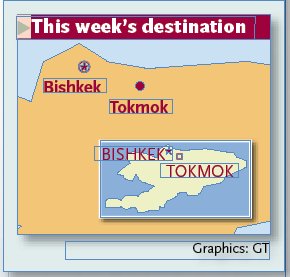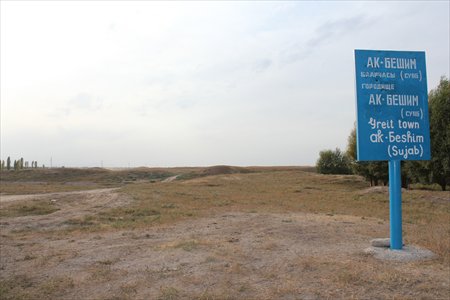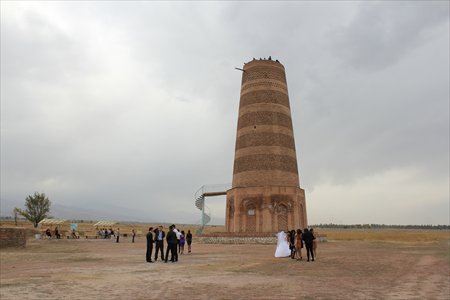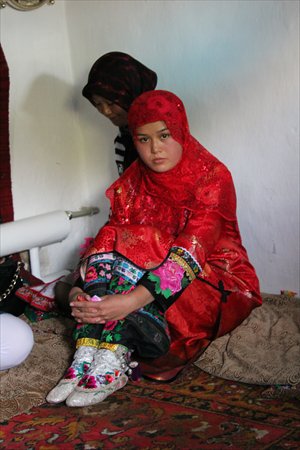Exploring Kyrgyzstan




Kyrgyzstan is probably many travelers' last choice as a destination. The impression most people have about the country is a sparsely populated piece of land - desolate, underdeveloped and sometimes disturbed by political instability.
But when I returned to Beijing after visiting this country, I missed the land and its people. I feel lucky that I had the chance to be there and see the place with my own eyes without being influenced by others' opinions.
There are not many skyscrapers or highways in this developing nation to impress visitors, but, looking back, I think their absence is what charmed me: the untamed trees flanking the roads, the stalls selling milk on the roadside, the relaxed attitude of the local people - even the shabby courtyards housing stacks of hay.
Bishkek, the capital
To people from modern metropolises, Kyrgyzstan's capital of Bishkek is more like a big village. But that is not necessarily a bad thing: A village means fresh air, simple people and an easy pace. It is an ideal place for those who are nostalgic about country life.
In Kirghiz, bishkek is the word for the stick used to stir fermented mare's milk. The city was called Pishpek until 1926, when it was renamed Frunze, after former Soviet Union military leader Mikhail Frunze who was born there. Today a bronze statue of Frunze still stands in front of the train station.
While the city was renamed in 1991 after the breakup of the Soviet Union, it still has numerous Soviet-style buildings. The mixture of old and new recalls the historical vicissitudes the city has experienced over the last century.
Rich in water resources, Bishkek is full of beautiful trees and foliage. During my autumn visit, the trees had not yet dropped their leaves, and they stood exuberant and full on the sides of the roads, along which ran narrow irrigation channels that gurgled as water flowed in streams from the nearby mountains. All this made me forget I was in a city.
But it certainly is a city. As the political, economic and cultural center of Kyrgyzstan, Bishkek is connected to a dozen other towns via buses, airlines and trains. Local transportation is also convenient, with buses, electric cars and taxis that will take you anywhere you want. And you don't need to worry about changing money: There are small booths all over the streets that sell som, the local currency, or US dollars, which can be used there.
One must-see spot is the National Historical Museum, where visitors are brought through the history of Kyrgyzstan via some very well-planned exhibitions. If time allows, tourists are advised to take in some ballet, modern drama or a puppet show to have a taste of traditional culture and art.
The city's museums and theaters serve as centers for people to gather and relax. These buildings usually have big squares, flower beds, statues and fountains in front of their gates, with people strolling idly and children playing nearby. The biggest square is Ala-Too Square, where the country's independence monument stands.
History-loaded Tokmok
Those who are interested in history cannot miss Tokmok. Sixty kilometers from Bishkek, the city is located in the north of Kyrgyzstan and borders Kazakhstan. It was the intersection of two main routes of the Silk Road in ancient times, gathering merchants from the East and the West.
Situated in the fertile Chui River Valley, Tokmok was the target of many medieval conquerors, witnessing many wars in its history. The city became a military outpost around the 1830s which fell to the Russians 30 years later and was demolished. The Tokmok of today was founded by Mikhail Chernyayev in 1864.
Today, the third-largest city in the country feels more like a village than Bishkek, shabby and old-fashioned. But it is full of the traces of history. A large airplane in military green with the city's name emblazoned on the side welcomes visitors as they enter the town. The city used to be the biggest training base for pilots in the Soviet Union.
The airports are closed today, but visitors still can get a glimpse of the city's past through its remaining airplane monuments. A white plane with a red pentagram stands grand in the center of one intersection, surrounded by trees and guardrails.
"It was once driven by former Egyptian president Hosni Mubarak, who was trained here," our guide explained.
The seemingly desolate city also boasts a commemorative square that memorializes soldiers killed during World War II and earlier wars. A flight of steps led us to a platform where statues of soldiers stood; several bouquets lay at their feet.
The names of fallen soldiers are inscribed on two walls surrounding the memorial, and on another wall, a statue of a man, eyes closed with his hand over his face, sits on the right side of the words, "Nobody will be forgotten. Nothing will be forgotten," to remind people of the terror of war.
The square is surrounded by two groves, with rows of chairs for resting. Locals were wandering around the monument. I came across a couple in their 40s, and the man asked me to take their picture. At first the woman was shy and covered her face with her hands, but finally the two smiled big, reflecting their contentment with the present life.
Burana Tower
Fifteen kilometers south of Tokmok stands Burana Tower, a large minaret built around the 11th century. Originally used for sermons, it once stood at 45 meters, but due to a number of earthquakes only 25 meters remain today.
It is a challenge to climb to the top of the tower, with its steep, narrow staircase that has room for only one person to pass, making for both fun and a sense of danger. But the scenery at the top was rather splendid and rewarding, with a great view of an area that once was a major trading center of the ancient Silk Road in the late 9th century.
The tower is believed to be located on the grounds of an ancient city called Balasagun, which was established at the end of the 9th century and was the capital of the Kara-Khanid Empire. The once-important trading center is now nothing more that a large mound of earth.
Standing atop the tower, I could only imagine the previous prosperity of the city and the busy traffic of caravans winding through intersecting paths surrounding the mound.
The many nearby gravestones, earthworks and castle ruins constitute an open-air museum. The gravestones, many engraved with human faces and hands holding cups, are said to serve as pictures for the dead.
According to legend, the tower was built by a local king to protect his newborn daughter who, according to a witch's prophesy, would die at 18. He allowed no one to enter except the servant who brought her food. But she died at 18 in the tower because a poisonous spider hid in the food that was brought to her.
The sad legend, however, doesn't prevent the tower from being a popular attraction for local newlyweds. I saw several newly married couples posing in front of the tower for photos in hopes that the long history of the tower would bring them a lasting marriage.
Expedition into Li Bai's hometown
Kyrgyzstan's Dungan people are the descendants of Chinese Hui people who fled mainly from Shaanxi and Gansu provinces to this area in the middle of the 19th century to escape wars. Many Dunganis, particularly older ones, can still speak their Chinese dialects. They have also preserved their way of life and customs, particularly when it comes to marriage and funerals.
Most Dunganis live in Tokmok, which is close to Syrab, the hometown of Chinese poet Li Bai (701-762).
It is tempting for any Chinese who comes here to visit the poet's birthplace, but such tourists are likely to be disappointed.
Syrab is famous because of Li Bai, but Li himself is unknown among locals, which was the first of many things to surprise me. I set off full of expectations, preparing myself for the long and hard trip. But even the route was difficult to navigate.
We stopped the car from time to time, asking the way. Unfortunately, most people just shook their heads. At one point we drove for about 30 minutes without seeing a single sign.
Even though the journey was hard, it was fascinating to have such an adventure. Along the way, far from any residence, we spotted large swaths of grassland along Tianshan Mountain, with flocks grazing here and there, reminding me I was in no-man's-land.
We came across a stand selling strawberries and we stopped to have a taste. They were amazingly sweet, and we were happy to have them on the bumpy road while we enjoyed the beautiful scenery outside the window.
About an hour later, the car stopped, and we disembarked on what looked like an abandoned piece of land. The area's landscape, with its endless hills and dips, looked just like everything else around. Even the dilapidated walls I read about online were gone. If I wanted to memorialize the poet's life, I didn't know where to stand.
For a second, I felt sad. It was a desolate place with no trace of history at all. I asked the guide again with doubt, and he pointed to a blue sign erected on a mound indicating that it was Syrab. With disappointment and great pity, we took pictures with the plate and the mound as a last memory.
I spent three days in the country, but it was too short because there was a lot more to see. My biggest regret is that I didn't see Lake Issyk-Kul, the "pearl" of Kyrgyzstan. But that also gives me a reason to visit the country once more.
Rules of Thumb
The best seasons to visit Kyrgyzstan are spring and autumn, when the temperature is mild. But bring enough clothes in case there is a sudden change of weather.
Flying is the most convenient way to get there. Tickets from Beijing to Bishkek cost around 2,000 yuan ($317.59).
After arriving at the airport, you can take a taxi or a private car to get to your hotel in Bishkek. For foreigners, it is probably most convenient to hire a car and driver that can take you around the capital and to other cities and sites.
Hotels in the downtown area are relatively expensive, around 700 yuan and above. Budget travelers are advised to find a hotel far from downtown to save money. Russian and Kirghiz are the two main languages spoken in Kyrgyzstan. It will help a lot if you learn some basic Russian or Kirghiz before your trip, though a guide and translator are a must for non-Russian visitors.